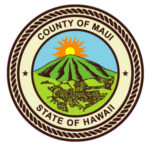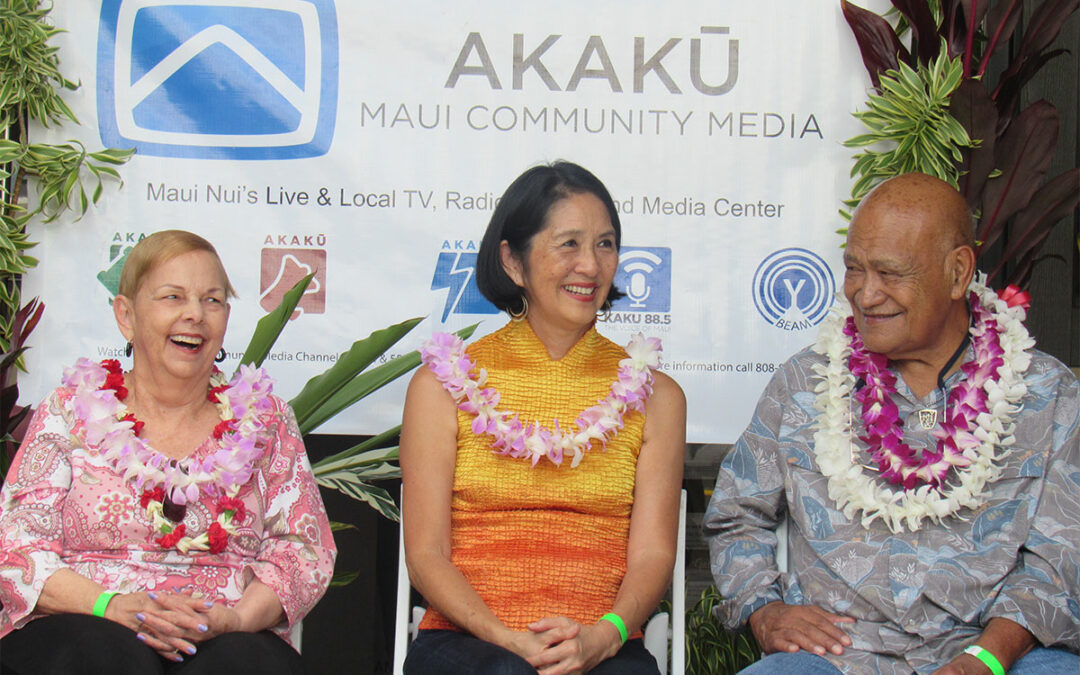
Jan 2, 2019 | Events
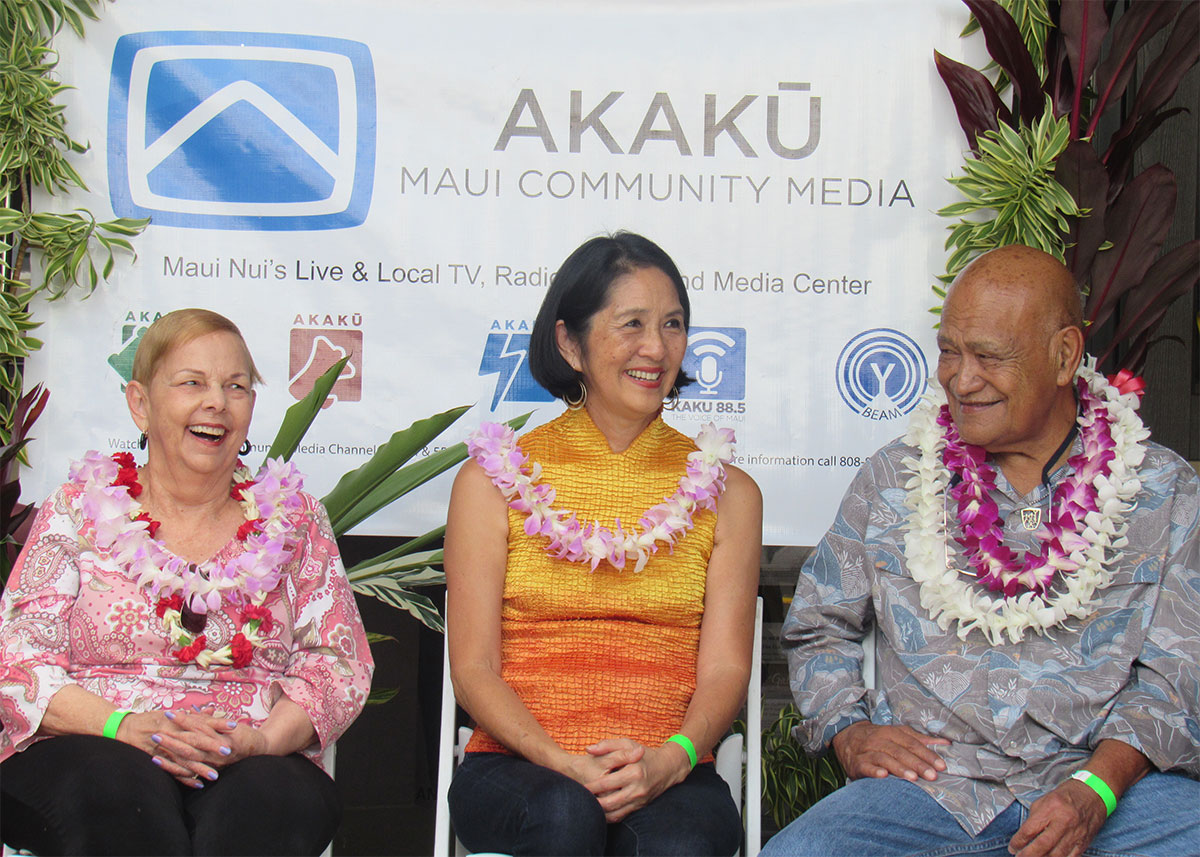
Akaku Maui Community Media presented its 5th Maui Walk of Heroes with a ‘Hands and Feet in Cement Ceremony’ honoring this year’s special guests, Former Maui County Councilwoman Chair Gladys Baisa; former Maui Economic Development Board (MEDB) CEO and president Jeanne Skog; and Uncle Les Kuloloio, defender of Makena and treasured kupuna.
In the most outstanding outdoor party of the year, three of Maui Nui’s favorite heroes were proudly enshrined alongside previous inductees. “We are honored to enshrine the handprints and footprints of these Maui Nui true heroes in cement,” said Jay April, CEO and president of Akaku. “The positive influences that Gladys, Jeanne and Uncle Les have had on keeping Maui No Ka Oi is immeasurable. It is hard to imagine life on Maui without their amazing contributions to our common good.”
Baisa said, “I’m honored to be a hero at Akaku. I’ve always liked to bring people together to focus on a goal. I’m Ms. Fix It! If there’s a community problem, I’ll find a way to get involved because that’s what aloha is all about. If you want to do it well, you must commit your life to the job. My advice to the youth of today is to focus on appreciation. Be kind and do what’s right.”
Skog added, “I too am humbled to be honored by Akaku. For 33 years I was inspired by MEDB’s mission to solve problems in the community by building a stronger economy for a better quality of life in Maui County. I had a lot of support at MEDB where everyone works together. I’m now volunteering in the community and consulting—my way to ‘Pay it Forward.’ My advice for today’s youth is, ‘Be Fearless!’”
Also honored to be at Akaku, Uncle Les concluded, “For me it’s all about family and community, protecting sacred places, and how we all fit together. Live the true meaning of ‘aloha’ and be a true keeper of the culture, with a deep sense of kuleana. Our youth need to overcome obstacles, stand firm, and love one another.”
It was wonderful to be part of MEDB’s vision to lead and inspire innovation in business, education, and technology, helping to lead the community toward building a vibrant economy. What a joy to be honored at Akaku with Gladys and Uncle Les!
Jeanne Skog, MEDB Former CEO & President
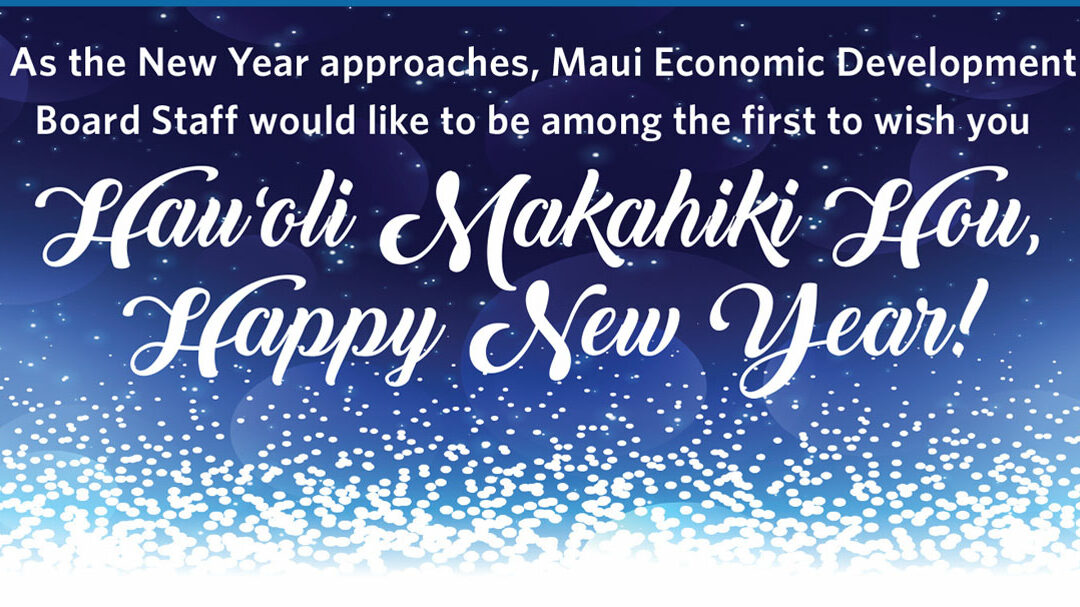
Dec 26, 2018 | Community
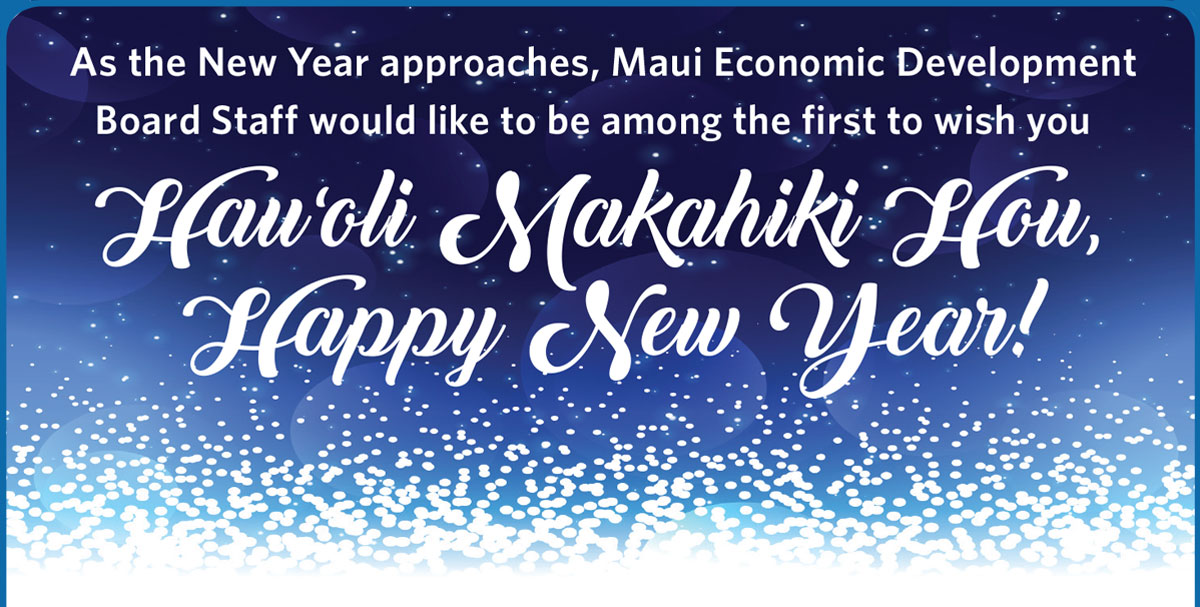
The New Year can be a time for reflection as well as a time for looking ahead to what will come, and what good fortunes the future can bring. As you reflect on 2018, you may look back at the highlights and feel appreciation for having those experiences. You can look at the challenges you faced and how you came through them – what were the lessons learned that you help make you and your new year better and even brighter.
The New Year is often a time for resolutions and here are ten suggestions for a stronger and healthier 2019.
- Sleep more – get those eight hours for better mental health.
- Pick up crafting or some other hobby – learn to knit, a new language or join an improv acting group to have some fun.
- Plan mini-vacays – don’t wait for your vacation to get away. Go camping or hop to another island.
- Walk more – take a break at work and walk around the block. Get your colleagues in on the act.
- Pay it Forward (Share the Aloha) – how can you pass on the help you’ve received in the past?
- Volunteer – Research shows volunteering can improve your health. There are lots of non-profits on Maui looking for your help.
- Learn new recipes – get out of a diet rut and introduce new recipes to your cooking repertoire.
- Smile at a stranger – make someone’s day and share your smile.
- Call your family more often – especially if they are not in Hawaii. Connect with loved ones.
- Be more positive – reduce complaining, and see the good in self, others and in the challenges you face.
There are countless more ways to resolve to make 2019 a remarkable one for you and those around you. Set yourself to succeed by being realistic and avoiding the all-or-nothing resolution. As you progress through the year, if you slip up on a resolution, don’t let that be the end of your resolve. To err is human, so give yourself a little slack, and just get back to your new habit.
As the New Year approaches, Maui Economic Development Board Staff would like to be among the first to wish you “Hau‘oli Makahiki Hou.” Happy New Year!
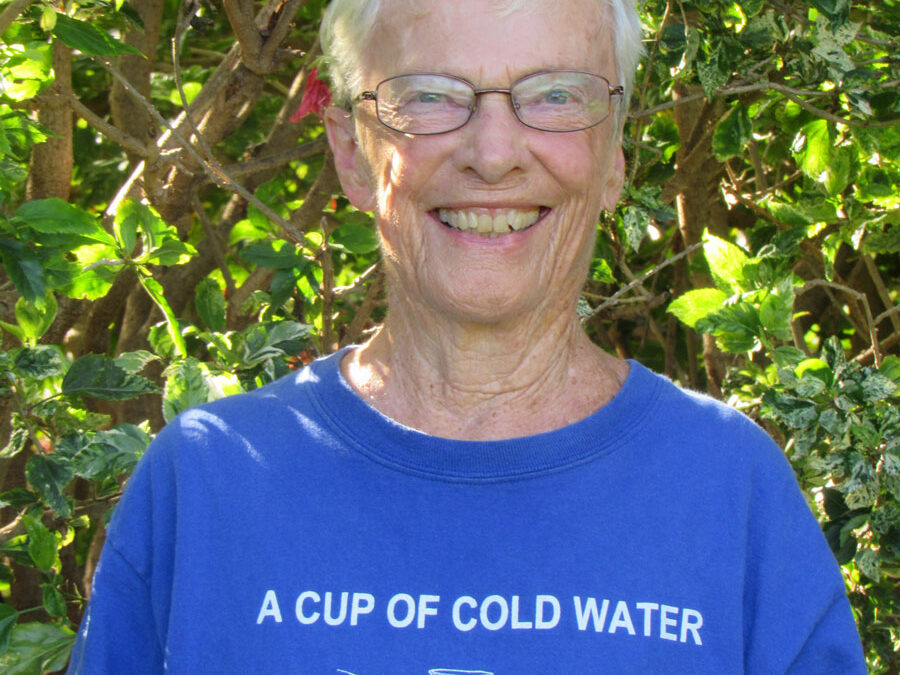
Dec 19, 2018 | Community
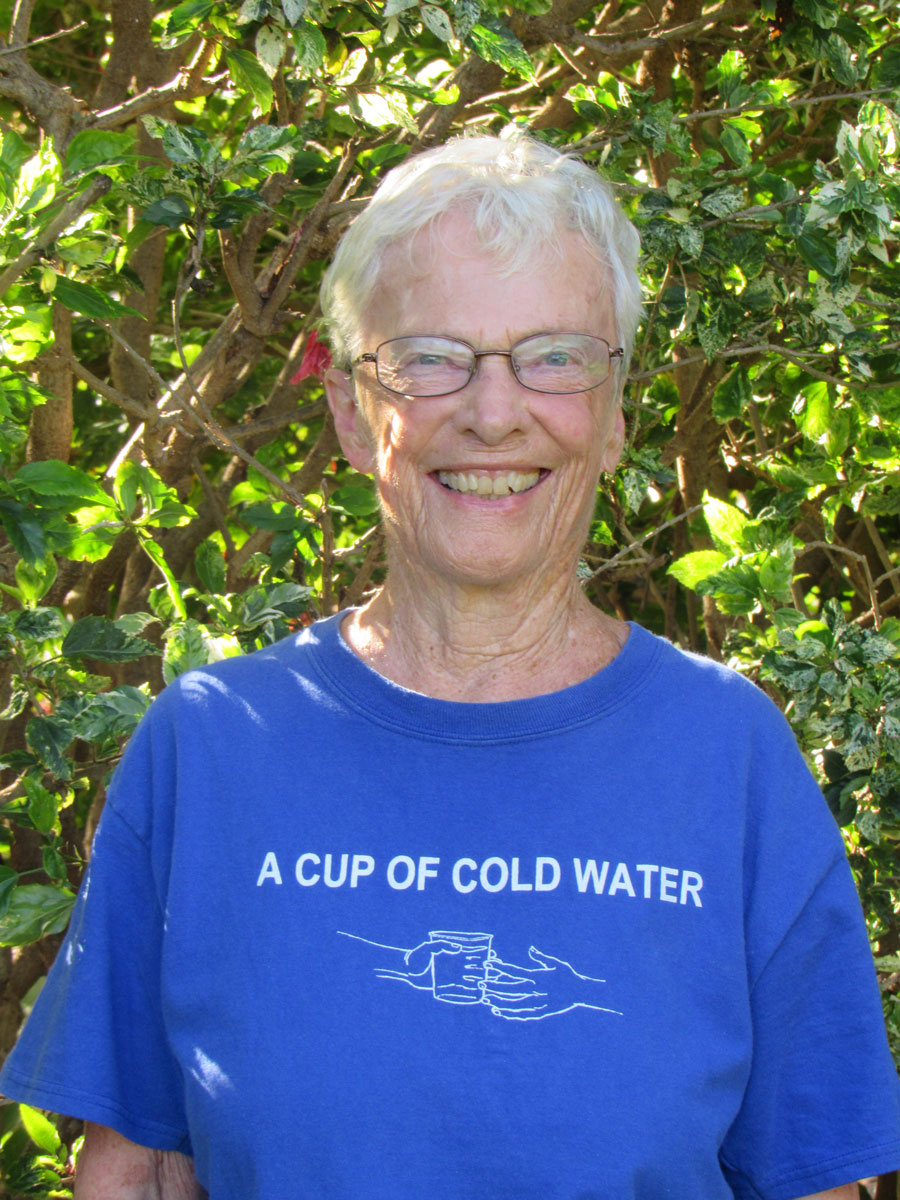
Paula Baldwin is the new president of A Cup of Cold Water (ACCW), the community care-van outreach program on Maui− distributing food, hygiene items and clothing to the needy in the community. The 501(c)(3) nonprofit organization has grown from its Episcopal Church inception to include numerous volunteers, churches, and organizations from around the island.
Baldwin took over the position as ACCW president from its founder, retired deputy police chief Keku Akana. “Baldwin is doing a fantastic job!” said Akana. “Becoming the president of an all-volunteer homeless outreach ministry with more than 70 volunteers and plenty of moving parts is no easy feat. Under Baldwin’s leadership the ACCW group, and other wonderful volunteers, have realized all-around better communications. We launched the ACCW e-newsletter, organized a hard-copy filing system to include operational and administrative forms, ensured regular and timely board meetings, and created open communications and bridging between the various units of ACCW, including run leaders, ride volunteers, supply team, and support staff. But most of all, Baldwin works and weaves her way through many of the subtle and behind-the-scenes challenges that an outreach such as ours encounters as we deal with day-to-day operations. She keeps things within the realm of simplicity, safety, and specificity, keeping it focused on the chronic street poor as we serve on the streets of Maui.”
Akana added, “Baldwin is a visible miracle, a woman of great strength, grit, and tenacity. She answered a call at a time in life when most women, or men, are content with a slow pace, a ‘me’ calendar, and an ‘I’ lifestyle.” Agreeing, ACCW volunteer Jean Fiddes said, “I want to thank Baldwin for saying ‘Yes’ to this earnest work, and for her heartfelt service.”
Baldwin said, “It gives me joy to use my organizational skills, to join committed friends, and watch ACCW continue to grow as a life-giving project. Life-giving for those we serve, and life-giving for us. We are all one community, serving and being served. I have always found that helping those in need brings more happiness to our own lives.”
The standard that ACCW set is to share resources with the approximately 750 in-need community members a month, with gratitude and service from the heart.
Paula Baldwin, ACCW President
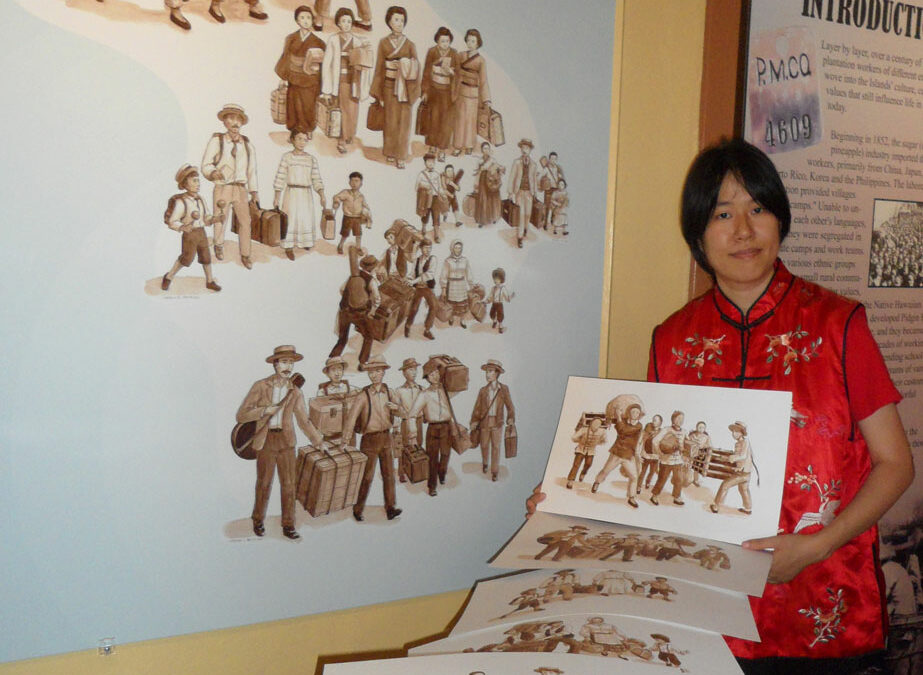
Dec 12, 2018 | Community

Lahaina resident Chutima Intarapanich, a cartoonist, comic artist, graphic novel artist, colorist, inker, illustrator, storyboard artist, and graphic designer, came to Maui for her master’s thesis in 2016. She undertook a project illustrating the background for a collection of paintings for the Lahaina Restoration Foundation’s (LRF) newly expanded Plantation Museum in Lahaina’s Wharf Cinema Center. The LRF restores and protects Lahaina’s historical legacies, celebrates its prominent place in Hawaii’s history and cultural traditions, and shares its story through preservation of significant sites, buildings, and artifacts.
Intarapanich, who received her Master of Fine Art in Graphic Novel Illustration in 2017 from the Academy of Art University in San Francisco said, “Research was very important in this Plantation Museum project. It is also important for creating truly original artworks. My art project consisted of creating a combination of six individual illustrations, showing the immigrants from six nations that moved to Hawaii: Chinese, Japanese, Portuguese, Puerto Ricans, Koreans, and Filipinos. The story is shown in six boards combined into one illustration, each board the story of one nation, its culture and its history.”
Clothes were a very big hint about the origins of people from Asia. Intarapanich had to research costume design based on what people working at the plantations in those days would be wearing.
In that time, people from a common geographic origin wore similar clothes, so she designed a combination of national costumes with influences from western culture.
“I measured the size of paper to plan how to draw the characters,” she explained. “After that I drafted the outline with curvilinear perspective to get the feeling of more space between them to highlight details of their lives in Hawaii. My art supplies consisted of sepia ink and fountain pen for inking the outlines, and sepia water color with brush and an old sponge for rendering, adding color, shading, and texture. Once my research and outlines for the six illustrations were completed, I finished the inking and painting. This LRF project was an extraordinary and educational experience.”
My art project at LRF illustrated and preserved art representing Lahaina’s different cultures, past and present.
Chutima Intarapanich, Maui artist

Dec 5, 2018 | Community

In December, Santa and his wife have a hectic schedule. Maui residents John and Lori Hughes, portraying Santa and Mrs. Claus, have been working for many years, directly under instructions from the North Pole. John Hughes, born and raised on Oahu, used to make appearances as Santa in the Kaneohe Christmas Parade. After moving to Maui in the late 90s, his Santa side awaited the right opportunity to continue volunteering. Lori Hughes, born and raised in Lahaina, always found ways to bring Christmas cheer by cookie baking, holiday decorating, even volunteering as a reindeer or elf for children’s events. Lori has contributed to the community for decades, volunteering her time—assisting the Maui Food Bank with distribution drives at Maria Lanakila Church, organizing food drives at her place of employment, reading to children in the Read Aloud America school programs, and much more.
“A few years ago, we decided to combine our volunteer efforts as Santa and Mrs. Claus,” said the Hughes, who now have authentic vintage Christmas outfits. “In collaboration with the Hansen family’s Annual Toy Drive, we made our first appearance benefitting the Friends of Children’s Justice Center. Additionally, we make appearances in the Kahului Library, the Kihei Library, the Maui Police Department’s Annual Children’s Holiday party, and other places in the community. In our Santa and Mrs. Claus personas we donate to the Maui Food Bank, lunch at Zippy’s, fill gas at Costco, pick up Christmas cards at Target, candy canes at Walmart, and visit local coffee shops. It takes people by surprise to see us out in the general public, not hired by the store, and not asking for money. We are simply humbled to have a moment with community members.”
Santa and Mrs. Claus concluded, “The magic we bring during Christmas ignites the spark to a child’s and adult’s imagination long after the holiday is over. It’s these moments of family and togetherness, smiles and laughter, that always live deep in our hearts. Santa and Mrs. Claus remind us to be kind to one another—that’s the most important thing. It’s all about love! Merry Christmas!”
Be sure to visit with us at noon on December 8th at the Kihei Library; on December 9th, 10am-2pm at Maui Makers to make toys and arts and crafts; and on December 23rd at 10am-1pm at the Westin Nanea to meet and take photos. Email mauisantaclaus@yahoo.com for more information.
Santa and Mrs. Claus
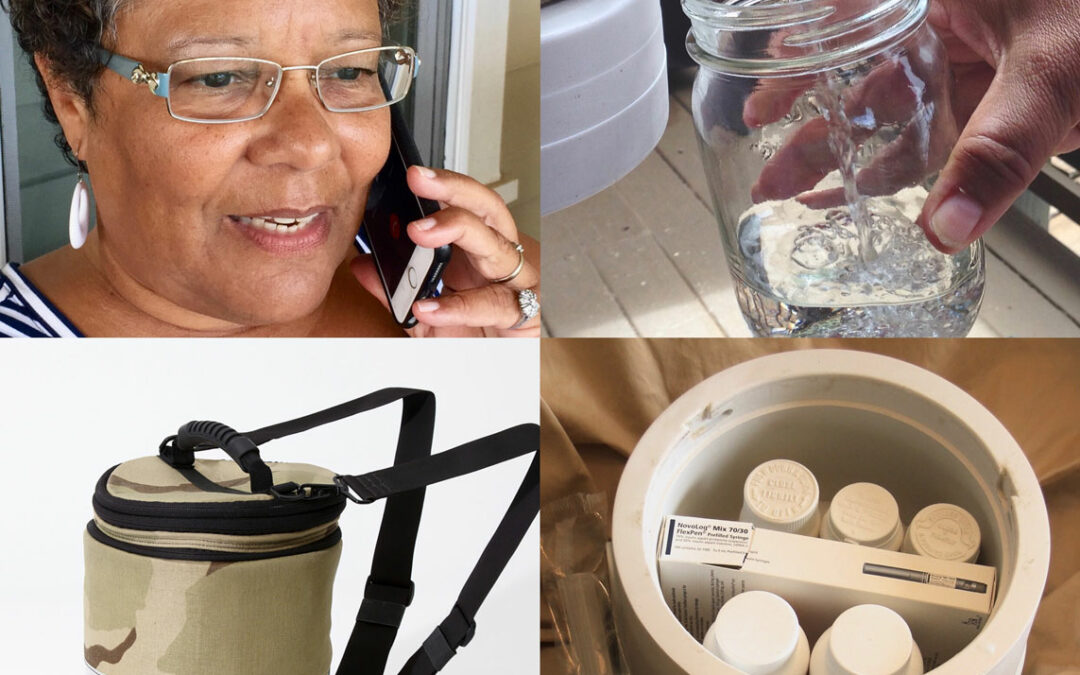
Nov 28, 2018 | Community, Small Business
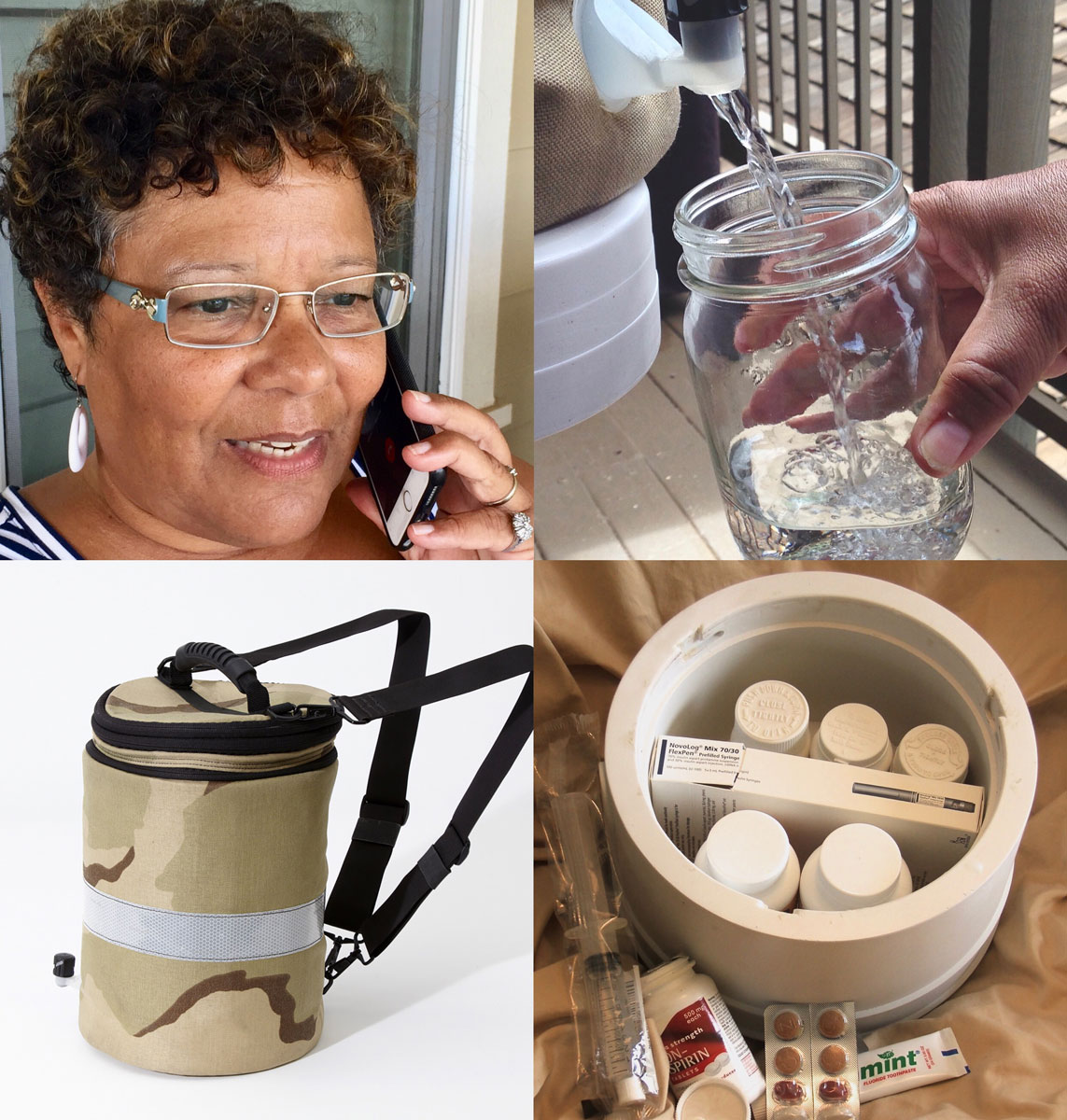
Pamela Norris, a Maui resident and entrepreneur, has participated in numerous High Tech Maui business development programs offered by Maui Economic Development Board (MEDB). Norris, winner of the Small Business Administration’s 2016 InnovateHer Challenge locally hosted by MEDB, is the creator of ICEBUDDY™ Systems, Inc., a portable cooling system comprised of the QPACK and QOOLER that enables ice, water, medication, and emergency supplies to be stored and easily transported.
“My career has been dedicated to saving lives,” Norris explained. “I spent years as a first responder during natural disasters where I saw people lose their lives due to not having their medicine with them, not having food or water, as well as a lack of medical supplies. Seeing turmoil due to lack of refrigeration catapulted me to create the ICEBUDDY™ Systems to respond to unmet needs, and to save lives by prepositioning emergency preparedness products.”
Norris explained, “The QOOLER utilizes a patented, encased, non-toxic gel, which is capable of keeping its contents cold at the 36-46-degree range for 72 hours. That is three days of cooling capability without the use of ice or gel packs, that would otherwise melt and sweat on whatever is stored.”
The QPACK module is an innovative, modernized backpack meeting military specifications. Its unique flexibility enables carrying whatever is available, be it 120 ounces of water, a 10-pound bag of ice or a dozen 16-ounce water bottles. The built-in bladder and spigot allow access to water critical for life itself and necessary for taking most medications. It can be carried as a backpack, but it also fits on wheelchairs and walkers for the elderly and disabled. Rescue crews can airdrop medical supplies in difficult to reach terrain.
“Recently, the African American Heritage Foundation of Maui has collaborated with ICEBUDDY™ to provide free QOOLERs and QPACKs to needy citizens in Hawaii,” Norris noted. “They are seeking tax deductible contributions that will be used for this humanitarian purpose. We at ICEBUDDY™ Systems desire to make this revolutionary product available globally, particularly to vulnerable populations living on islands.” Visit www.icebuddy.net for information.
MEDB’s High Tech Maui business programs are focused on helping local entrepreneurs gain the needed edge and skills to succeed.
Pamela Norris, Founder, ICEBUDDY™ Systems

Nov 21, 2018 | Community, Environment
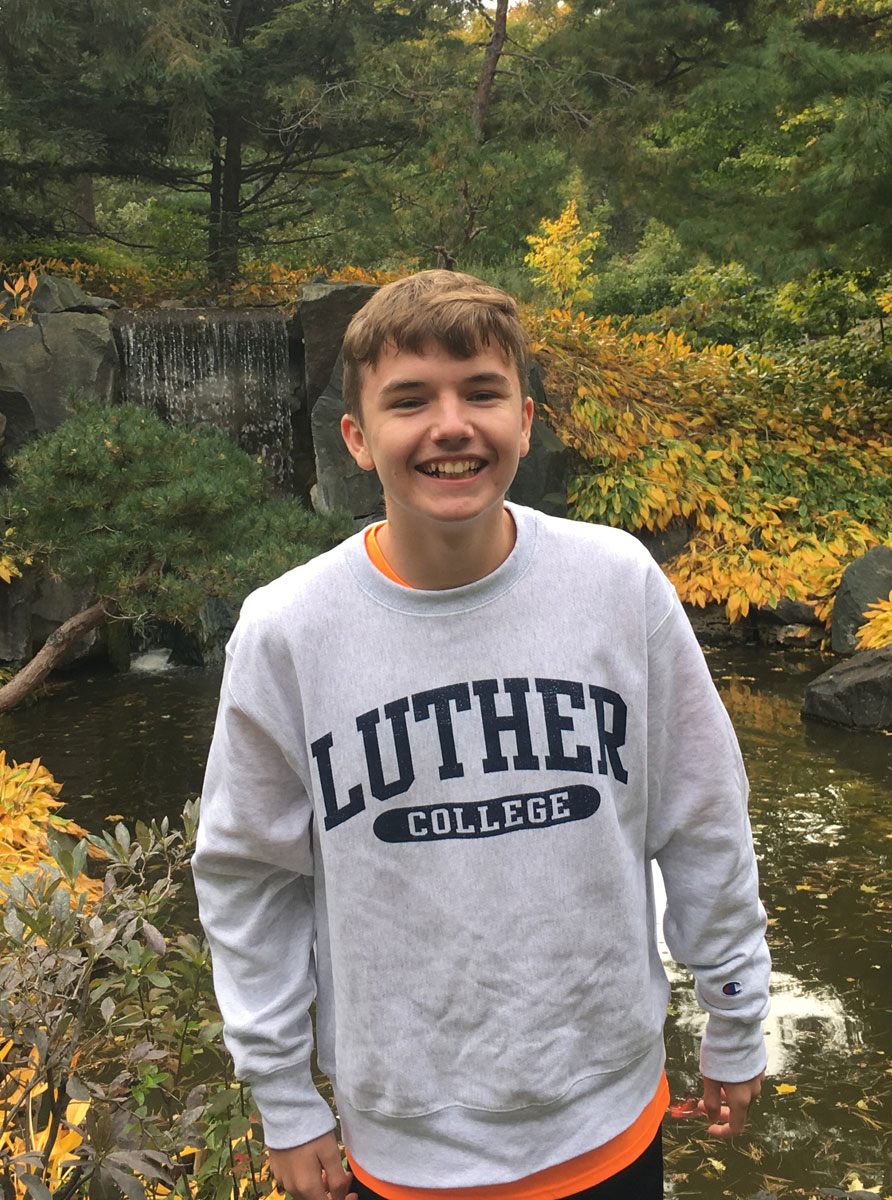
In this season of thanksgiving, we can gain inspiration from Matteo Musso, a frequent visitor to Maui, is a 14-year-old author, speaker, yet mostly non-verbal autistic young man. After almost 12 years of silence, Musso found his voice by spelling his thoughts, one letter at a time, on a stenciled letter board called a flatboard. His inspired thoughts, wisdom, and tips on autism are now being shared with the world.
Musso has given presentations at the Maui Autism Center, the Wisdom Center for Autism, on Maui Source TV, and wrote an article in Maui Vision Magazine. His books, “I am Yours” and “Love Land” are available on Amazon. He also has a YouTube series, Mondays with Matteo.
“It’s been a long road that led us to the miracle of finally getting to know Matteo,” said his mom, Annette. “He was diagnosed formally at age three, and after many years of difficult therapies was introduced to the Son-Rise program. Through the Rapid Prompting Method, he learned to communicate using the flatboard, which acts as a conduit between his deep thoughts and the expression of them in an understandable way.”
Annette continued, “Amazingly, Matteo was able to tell us what he thinks his life purpose is. He said he agreed with God to be a voice for the silent ones on this Earth and to encourage all of society to stop judging each other and move toward total acceptance of our differences, to see them as gifts which can bond us together instead of separating us. We can lift each other up even though our minds work differently, and we experience life in varied ways. Our differences provide depths of perspective, giving us many gifts to share.”
In a message of thanksgiving, Matteo said, “If we desire beautiful and fruitful crops in our lives, we don’t get to be bystanders. Seeing the good is an active choice on our part. Search for the things that are beautiful in your day. Notice the beauty that’s around you no matter what’s going on. We can plan our healthy harvest, then harvest the happiness that we have nurtured—even through the storms.”
Through a recent miraculous discovery, his trapped intelligence released, Matteo now shares amazing insights of love, God, finding happiness, and the gifts of autism.
Annette Musso, Matteo’s Mom
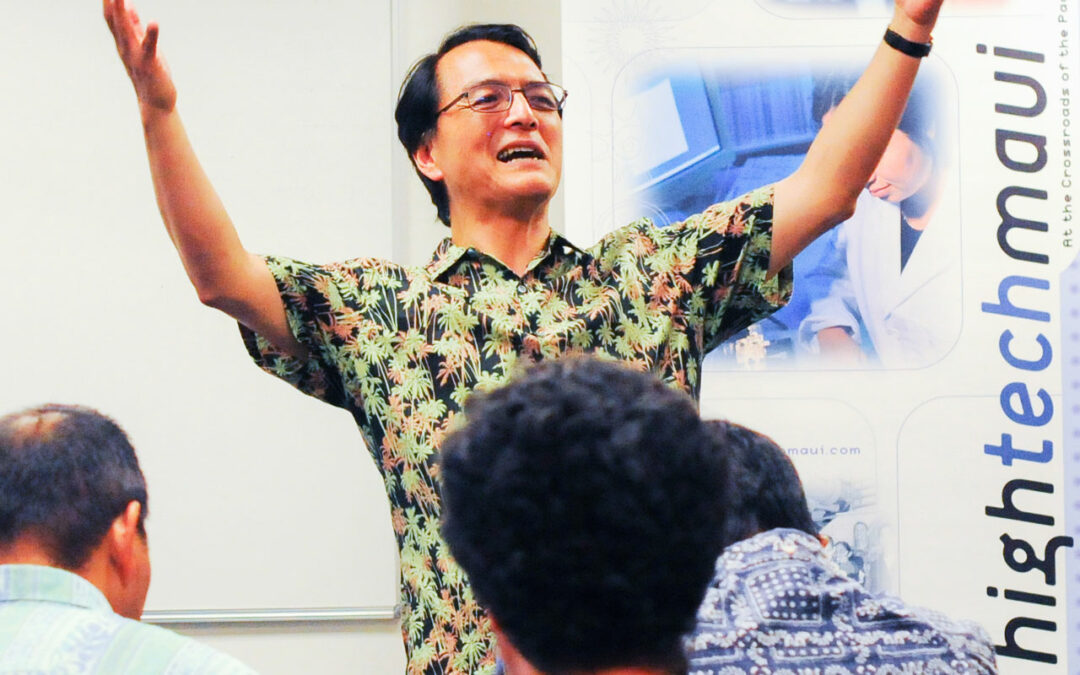
Nov 14, 2018 | Innovation
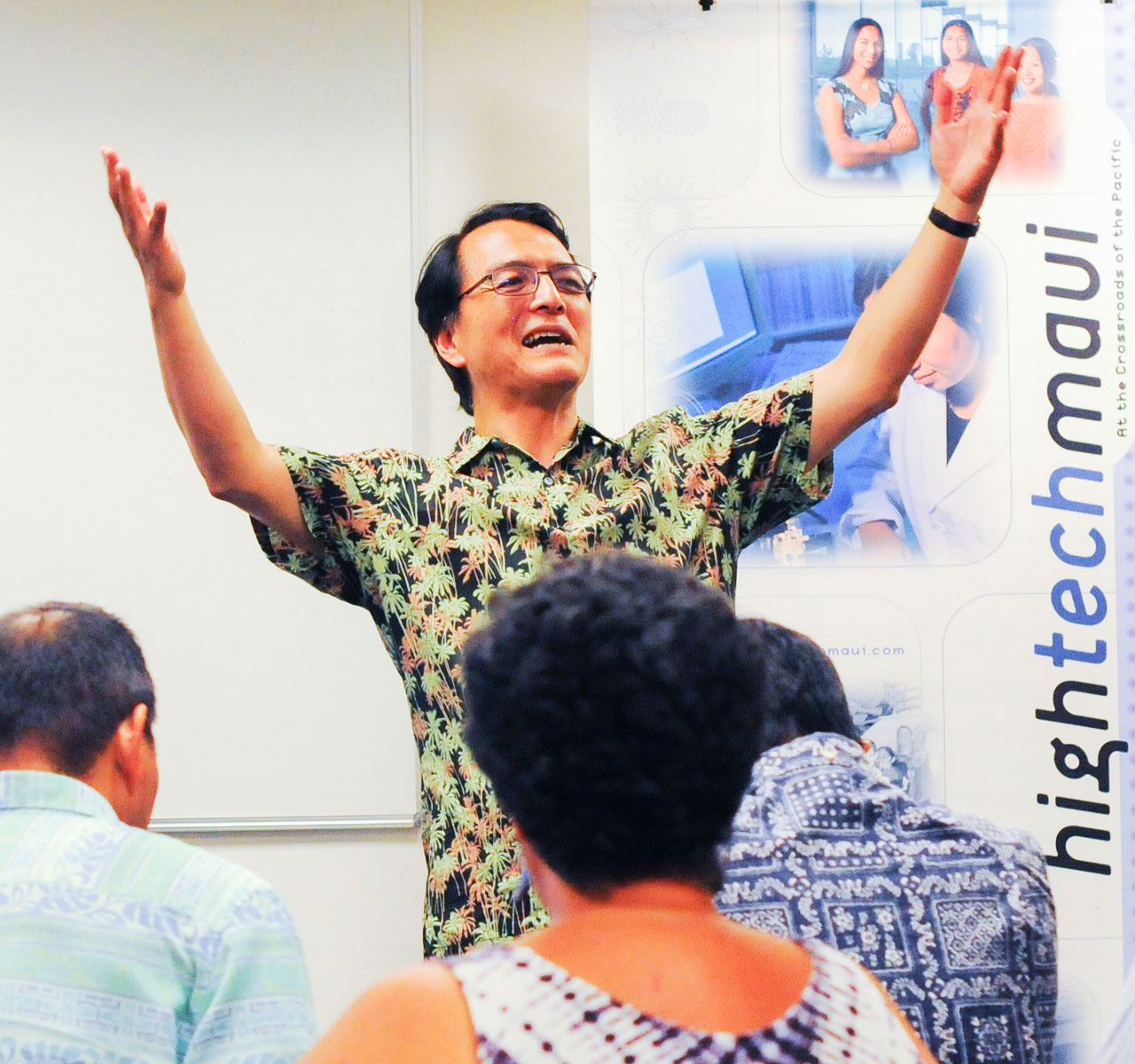
Maui Economic Development Board (MEDB) recently held an informal public event, Maui TechOhana@Cohana, featuring Dr. David Ai, Director, Office of Innovation and Commercialization and Chief Innovation Officer of the University of Hawaii (UH) System. Maui TechOhana meetings provide an informal networking opportunity open to anyone interested in Maui’s technology industry.
“The TechOhana meetings are a great opportunity to share views and thoughts in an open forum,” said Gerry Smith, MEDB Director of Business Development. “The reason MEDB has these events is to offer presentations on relevant topics in business and technology, followed by the opportunity to talk with others with similar professional interests.”
Dr. Ai detailed how the University of Hawaii plans to work with local constituents to promote innovation and entrepreneurship throughout the state. An international expert in management and business administration, Ai has more than 20 years of experience in various positions with large corporations and venture companies. In his UH position, he is responsible for the protection of intellectual property and UH-developed technology transfers and assets.
“I am thrilled to join the University of Hawaii System, and to help drive the innovation agenda with colleagues on 10 campuses– placing the research institutes under one umbrella,” said Ai. “Hawaii has a long and proud history of diversity, which is the most important ingredient of innovation.”
Pamela Norris, an entrepreneur and TechOhana participant, commented on the presentation which outlined Dr. Ai’s vision for his newly formed Departments within the UH system. “He brings a wealth of knowledge and broad practical experience to his position,” Norris said. “Ai’s vision is to upgrade the University’s ability to commercialize research results by students and faculty, in collaboration with community businesses. Businesses can apply for government grants jointly with a university faculty member who may be interested in the endeavor. Moreover, leaders in the community can offer opportunities to apply classroom knowledge to real life business challenges where they partake in community solutions.”
Maui TechOhana meetings will resume in the new year. Learn about these events by signing up for news and updates at medb.org
I am thankful for Maui TechOhana which is presented by MEDB, the County of Maui, Mayor’s Office of Economic Development, and the Hawaii Technology Development Corporation. The meetings create opportunities for people to come together, learn, find inspiration, and make new friends.
Dr. David Ai, Director of the Office of Innovation and Commercialization and Chief Innovation Officer of the University of Hawaii System

Nov 7, 2018 | Innovation
Startup Weekend Maui is on November 16-18. Learn how to launch a startup in just 54 hours while receiving invaluable insights and advice from this year’s coaches and judges.
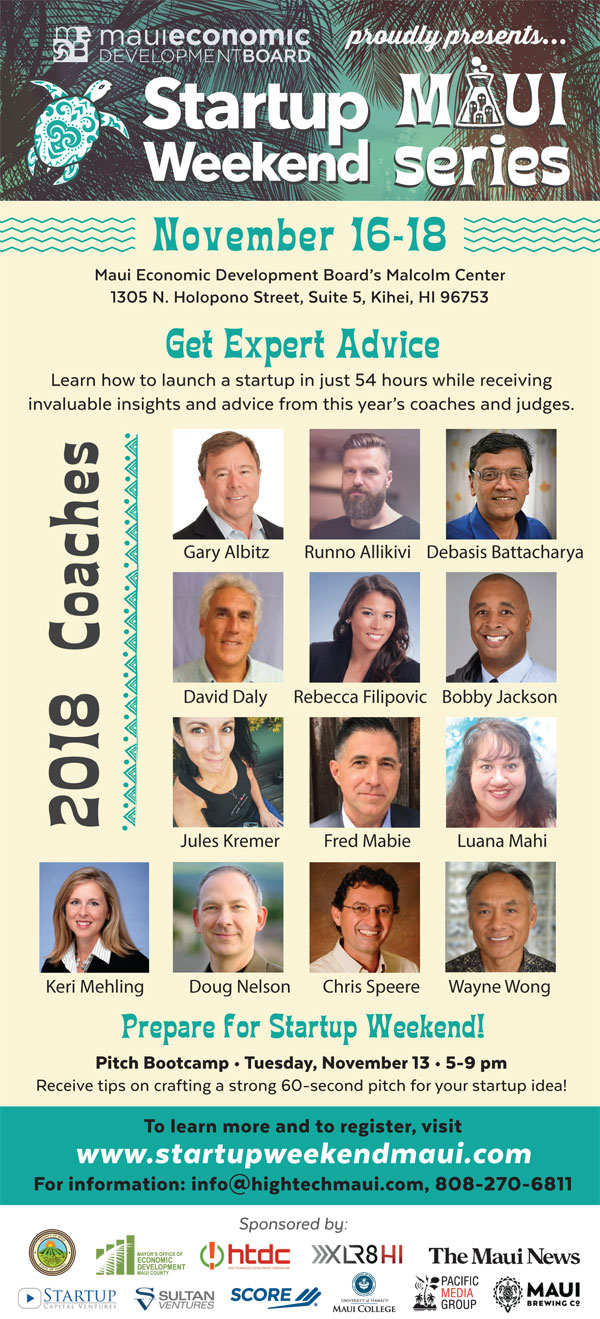
Coaches
- Gary Albitz, FocalPoint Business Coach and Lecturer UH Maui College
- Runno Allikivi, Head of Scandinavia at Funderbeam
- Debasis Battacharya, Assistant Professor, UH Maui College
- David Dal, BDC Director, MEO, Inc.
- Rebecca Filipovic, Attorney, McKeon Sheldon Mehling
- Bobby Jackson, Business Coach, RedRidge Consultants
- Jules Kremer, Technical Project Manager at Google
- Fred Mabie, Faculty member – UH Maui College, ABIT
- Luana Mahi, Owner, Principal Broker, Kismet Brokerage; President of Maui Food Technology Center
- Keri Mehling, Attorney & Partner, McKeon Sheldon Mehling
- Doug Nelson, President, Kinection
- Chris Speere, Site Coordinator,UH Maui College’s Maui Food Innovation Center
- Wayne Wong, Director, Hawaii Small Business Development Center – Maui Center
Judges
- Virendra Nath, President HDEP International
- Michael Powells, Founder Splash Inc.
- Teena Rasmussen, Director of the Mayor’s Office of Economic Development (OED)
Get ready!
Prepare for Startup Weekend Maui with Pitch Bootcamp, Tuesday November 13. Get tips to craft a strong 60-second pitch for your startup idea!
For more information and to register, please go to www.startupweekendmaui.com
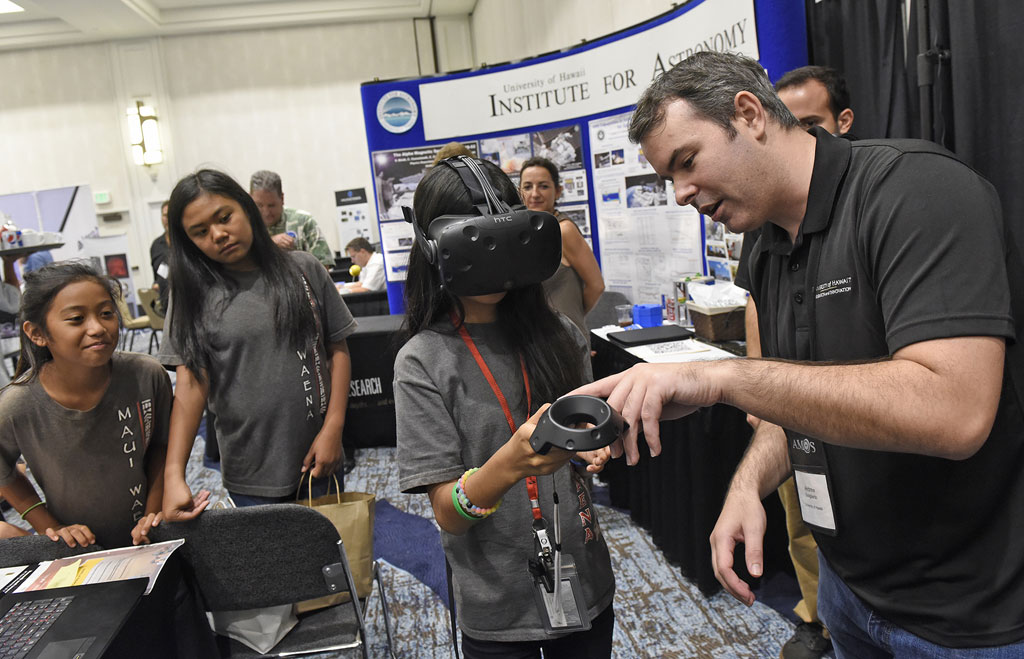
Oct 31, 2018 | Innovation

The 17th Annual Advanced Maui Optical and Space Surveillance Technologies (AMOS) Conference was held on September 20-23 at the Wailea Marriott Resort and Spa with a record-breaking attendance of over 670 participants from 18 countries. A program of the Maui Economic Development Board (MEDB), AMOS is the premier technological conference in the nation devoted to Space Situational Awareness (SSA), knowledge of objects in orbit around the Earth. Over 100 technical papers were presented along with featured speakers, poster sessions, exhibits and short courses in the fields of telescope optics, adaptive imaging, and astrodynamics.
Graduate and undergraduate students Andrew Guagliardo and Ryan Theriot from the University of Hawaii Manoa Laboratory for Advanced Visualization and Applications (LAVA) developed
new ways to visualize big data for satellite technology. “We exhibited our program called SatWatch, a virtual reality exploration of satellite orbits around Earth,” Guagliardo explained. “By pulling publicly available data from the Celestrak website, SatWatch is able to create a predictive model of orbits for a wide variety of satellites. SatWatch is an example of a complex dataset represented in an intuitive way, allowing users to easily understand satellite orbits in an interactive visualization environment.”
Maui middle school students participated in hands-on STEM (science, technology, engineering, and mathematics) activities during the Space Exploration Student Session at AMOS. They were introduced to space technologies via exhibits and science projects tailored especially for them.
“I enjoyed learning and talking to the experts at the AMOS Conference,” said Czerena Martinne Boyle, Maui Waena Intermediate School 8th grader. “My favorite booth was SatWatch, a virtual reality exploration of satellite orbits around the Earth. Through the virtual reality headset, I got to explore SSA data of numerous satellite orbits. These satellites make a big impact on the community and in the world for national security, internet, banking, telephones, television, navigation, scientific exploration and more.”
Seeing satellites orbit the earth through a virtual reality headset was an amazing experience!
Czerena Martinne Boyle, Maui Waena Intermediate School, 8th grade



















